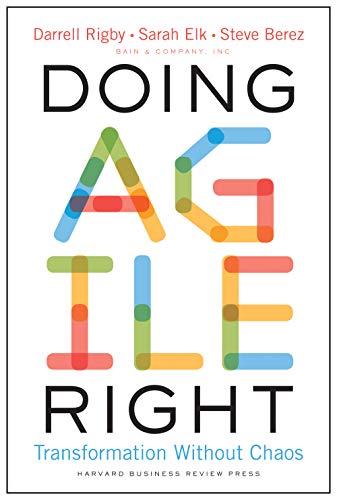Doing Agile Right: Transformation Without Chaos Link to heading
Summary Link to heading
“Doing Agile Right: Transformation Without Chaos” by Steve Berez, Sarah Elk, and Darrell Rigby is a comprehensive guide on how to successfully implement Agile methodologies within an organization while avoiding common pitfalls and chaos. The book emphasizes the importance of understanding that Agile is not just a set of practices or tools but a mindset that can transform how companies operate and deliver value. It outlines how organizations can balance Agile processes with traditional management practices, leverage Agile for strategic advantage, and develop a culture that supports continuous learning and adaptability.
Review Link to heading
“Doing Agile Right” comes highly recommended for its pragmatic approach towards Agile transformation. The authors, with their extensive experience in advising companies, provide valuable case studies and examples that illustrate both successes and failures in Agile adoption. One of the book’s strengths is its focus on the cultural and managerial changes necessary for Agile to thrive—not simply the adoption of specific practices.
Critically, while the book offers insightful strategies, some may find its recommendations broad and in need of more specific, actionable advice suitable for smaller teams or companies with limited resources. Despite this, the book remains a solid resource for larger organizations aiming to scale Agile practices effectively.
Key Takeaways Link to heading
- Agile is a Mindset: Successful Agile adoption requires a shift in mindset and culture beyond just implementing Agile practices or frameworks.
- Balanced Approach: Organizations should maintain a balance between Agile and traditional management to support both innovation and operational efficiency.
- Strategic Alignment: Agile efforts should align with the company’s strategic objectives to ensure meaningful outcomes and sustainable competitive advantage.
- Cultural Change: Fostering a culture of trust, adaptation, and psychological safety is critical to support Agile transformation and continuous improvement.
- Pilot and Scale: Start with small, cross-functional teams to pilot Agile practices and scale gradually based on early successes and learnings.
Recommendation Link to heading
“Doing Agile Right” is recommended for business leaders, managers, and consultants who are seeking to drive Agile transformations within their organizations. It is especially useful for those in larger enterprises or those experiencing challenges with scaling Agile practices. The book provides a balanced perspective and realistic guidance on how Agile, when done right, can lead to significant improvements in performance and innovation.
